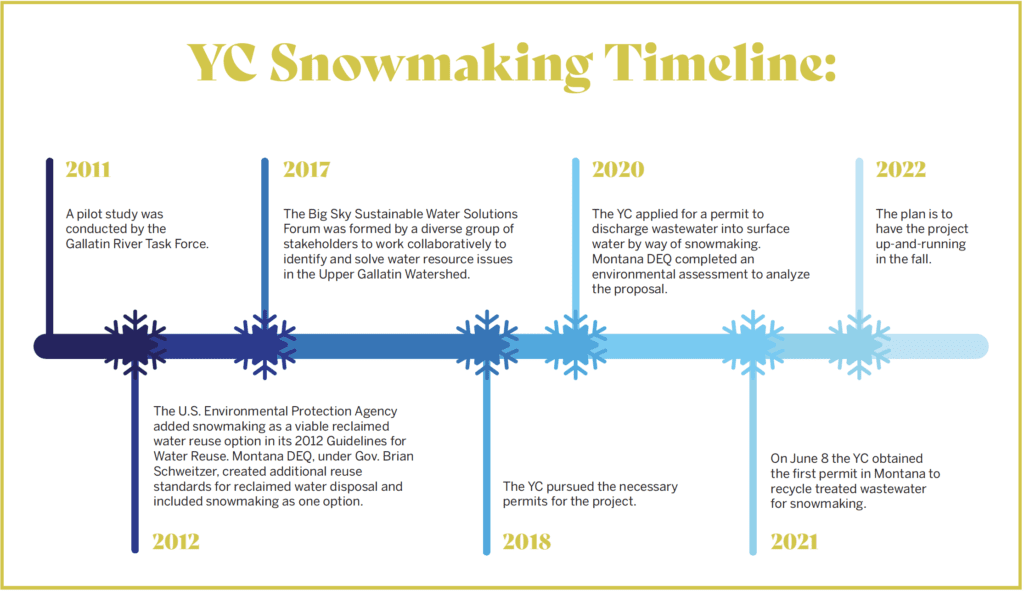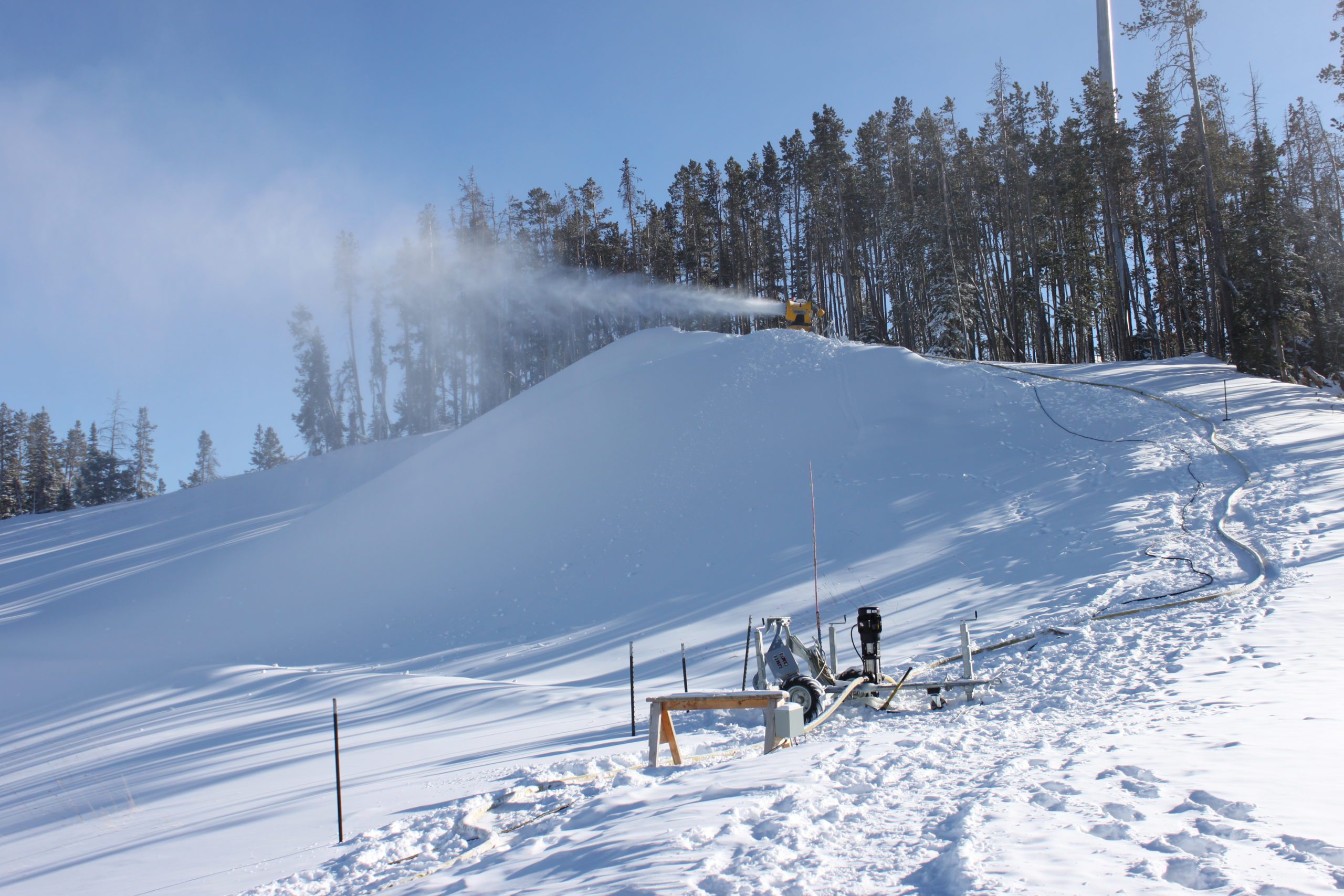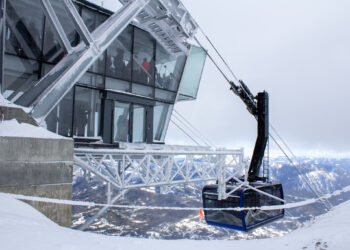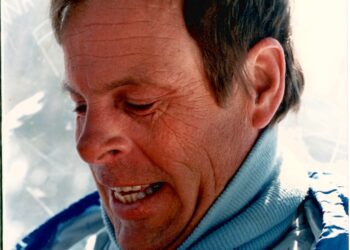With DEQ permit in hand, private club moves toward actuating historical initiative
By Bella Butler and Gabrielle Gasser EBS STAFF
BIG SKY – On June 8, in the midst of a water shortage in Big Sky and early summer drought statewide, the Yellowstone Club, a private residential, ski and golf club near Big Sky, obtained the first permit in Montana to recycle treated wastewater for snowmaking.
The club currently uses freshwater to make snow, and, according to its proposal, using recycled wastewater instead could result in a net benefit of 25-million-plus gallons of water to the local aquifer and watershed.
Rich Chandler, environmental manager for the Yellowstone Club reported that 75 to 80 percent of the water will be sourced from the Big Sky County Water and Sewer District and 20 percent will be drawn from the YC Wastewater Treatment Plant.
“Fortunately, we have the opportunity to do a great project that will help conserve our limited water supply and protect the watershed,” Chandler said in a June 8 press release. “Hopefully there are more projects coming online like this in the future.”
In Big Sky, water is increasingly limited as demand rises. A graph shared at a Jan. 19 Big Sky County Water and Sewer meeting illustrates a deficit in water demand and supply occurring around 2024. June drought reports in Montana show a drying trend throughout most of the state in recent years, including in Gallatin and Madison counties.
Proponents of the snowmaking initiative say that the process will produce water that’s even cleaner than the treated wastewater currently used to water four area golf courses. When the water is blasted through the snow gun, it freezes, reducing the amount of E. coli in the water, explained Kristin Gardner, executive director of the Gallatin River Task Force. After the snowmaking process, the amount of nutrients in the water is reduced even further by microbes in the soil and by the plants that uptake it.
“When you’re putting that water back into the watershed, you’re essentially building a water bank that can supply our streams and aquifers with water later in the year when we need it most,” Gardner said. “We see this as a huge win for both water supply resiliency and for supporting our ski industry and economy.”
Patrick Byorth, Montana water project director with Trout Unlimited, a
national nonprofit organization with local chapters committed to river conservation and restoration, also emphasized the benefits of the project to the surrounding ecosystems.
“I have to applaud the Yellowstone Club’s significant investment, leadership and innovation,” Byorth said. “More clean, cold water is just plain good for the Gallatin, its fisheries and downstream agriculture.”
The idea to use treated wastewater to make snow in Big Sky was born in 2011 when GRTF conducted a pilot study to test the concept. That study expanded to include the Montana Department of Environmental Quality and formed the basis for the club’s current project.

In 2012, the U.S. Environmental Protection Agency added snowmaking as a viable option in its 2012 Guidelines for Water Reuse. Additionally, Montana DEQ, under Gov. Brian Schweitzer, created additional reuse standards for reclaimed water disposal and included snowmaking as one option.
A diverse group of stakeholders in 2017 formed the Big Sky Sustainable Water Solutions Forum to identify and solve water-resource issues in the Upper Gallatin Watershed. Chandler was a part of the forum when it formed and said the plans and support from that group created the foundation for the snowmaking project.
In March 2020, the Yellowstone Club applied for a permit to discharge wastewater into surface water through snowmaking. Montana DEQ completed an environmental assessment to analyze the proposal, required by the Montana Environmental Protection Act when potential impacts of a proposal are unclear.
The assessment considered the proposed action’s impacts on 23 resources, from air quality to soil quality to less tangible resources like social structures and cultural uniqueness. The assessment found that impacts to all resources considered would be insignificant or not present.
The assessment received what Jon Kenning, Montana DEQ’s water protection bureau chief, later recounted in a press release as “an outpouring of support letters” from several members of the public, local entities and environmental organizations like GRTF, American Rivers, Big Sky County Water and Sewer District, Lone Mountain Land Club with the Spanish Peaks Mountain Club, among others.
But not everyone supported the concept. John Meyer, executive director of Bozeman-based Cottonwood Environmental Law Center, wrote that the assessment failed to “analyze the impacts of pharmaceuticals reaching surface waters.” DEQ responded by stating that “pharmaceuticals” is a general term and an “emerging area of science and research concerning water quality.” DEQ has not yet adopted water quality standards for pharmaceuticals, according to its response to Meyer.
Cottonwood is currently suing DEQ in another matter related to the designation of the Gallatin River as an Outstanding Resource Water. The law center is joined in that suit by fellow plaintiffs Gallatin Wildlife Association and Montana Rivers, both of which also provided comment alongside Meyer critiquing the environmental assessment of the Yellowstone Club’s snow
making proposal.
The assessment evaluated the effluent’s impact on nearby Muddy and Third Yellow Mule creeks. Meyer, Gallatin Wildlife Association and Montana Rivers also issued comments about the assessment’s failure to consider the impact to the Gallatin River and disclose those impacts to the public.
DEQ stated in response that the permit the Yellowstone Club applied for regulates point-source discharges to the creeks and no discharge directly into the Gallatin is permitted. DEQ added that the permit comes with effluent limits and monitoring requirements to protect “beneficial uses” of the creeks.
“Just because DEQ approved of something doesn’t mean that it’s the best policy,” Gallatin Wildlife Association President Clint Nagel told EBS in a June 15 interview.
The environmental assessment considered the Yellowstone Club’s proposal against an alternative they identified as “no action.” This would have meant denying the permit, according to the assessment, leaving the club to work with the water and sewer district to find other options for effluent disposal, including “potential direct discharge to the Gallatin River,” according to the assessment.
Meyer stated in a June 14 interview with EBS that he would be challenging the permit issued to the Yellowstone Club with a lawsuit.
In the wake of Montana DEQ’s approval of the club’s discharge permit, GRTF will be conducting a new study in Big Sky, likely starting in the fall of 2021, to assess the viability of Big Sky Resort and Spanish Peaks Mountain Club also using treated wastewater to make snow.
The study, funded by Lone Mountain Land Company, Big Sky Resort, Big Sky County Water Sewer District and Big Sky Resort Area District, will focus on three factors: environmental impacts, the snow amounts the resorts want to make, and how much water exists in the water and sewer district. Gardner said the current goal is to work with the partners to understand their needs and to gather the necessary data needed to apply for a DEQ permit.
Taylor Middleton, president and COO of Big Sky Resort, provided public comment in favor of the club’s initiative.
“All communities must collect, treat and dispose of waste, but few do it as well as Big Sky has for the past 50 years, recycling 100% of our wastewater on golf courses,” Middleton wrote in a statement to EBS. “Now, our rapidly growing community is doubling down on that recycling commitment and using snowmaking technology to attain it. There’s no reason we can’t look back in another 50 years and be proud that we’re still a 100% recycle community.”
For now, the Yellowstone Club is looking to its own next steps. It’s currently working through the engineering review process with DEQ, according to Chandler, which he expects to wrap up within 90 days. The club will then start looking to award construction contracts.
The last piece of the puzzle will be obtaining a stormwater permit, Chandler said, adding that the goal is to get the project up and running by fall of 2022.
“I hope that we get to see expanded use of treated wastewater now throughout our community and Montana,” Gardner said. “I really do see it as a huge benefit in proactive management measures toward those predicted changes in climate.”














